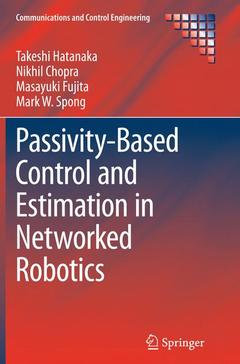Description
Passivity-Based Control and Estimation in Networked Robotics, Softcover reprint of the original 1st ed. 2015
Communications and Control Engineering Series
Authors: Hatanaka Takeshi, Chopra Nikhil, Fujita Masayuki, Spong Mark W.
Language: English
158.24 €
In Print (Delivery period: 15 days).
Add to cartPublication date: 10-2016
Support: Print on demand
158.24 €
In Print (Delivery period: 15 days).
Add to cartPublication date: 04-2015
349 p. · 15.5x23.5 cm · Hardback
Description
/li>Contents
/li>Biography
/li>Comment
/li>
Highlighting the control of networked robotic systems, this book synthesizes a unified passivity-based approach to an emerging cross-disciplinary subject. Thanks to this unified approach, readers can access various state-of-the-art research fields by studying only the background foundations associated with passivity. In addition to the theoretical results and techniques, the authors provide experimental case studies on testbeds of robotic systems including networked haptic devices, visual robotic systems, robotic network systems and visual sensor network systems.
The text begins with an introduction to passivity and passivity-based control together with the other foundations needed in this book. The main body of the book consists of three parts. The first examines how passivity can be utilized for bilateral teleoperation and demonstrates the inherent robustness of the passivity-based controller against communication delays. The second part emphasizes passivity?s usefulness for visual feedback control and estimation. Convergence is rigorously proved even when other passive components are interconnected. The passivity approach is also differentiated from other methodologies. The third part presents the unified passivity-based control-design methodology for multi-agent systems. This scheme is shown to be either immediately applicable or easily extendable to the solution of various motion coordination problems including 3-D attitude/pose synchronization, flocking control and cooperative motion estimation.
Academic researchers and practitioners working in systems and control and/or robotics will appreciate the potential of the elegant and novel approach to the control of networked robots presented here. The limited background required and the case-study work described also make the text appropriate for and, it is hoped, inspiring to students.
Scattering Variables Based Control of Bilateral Teleoperators.- Synchronization of Bilateral Teleoperators.- Passivity-Based Visual Feedback Estimation.- Passivity-Based Visual Feedback Control.- Output Synchronization for Network of Passive Systems.- Attitude Synchronization for Rigid Body Networks.- Pose Synchronization for Rigid Body Networks.- Cooperative Estimation for Visual Sensor Networks.- Appendices.




